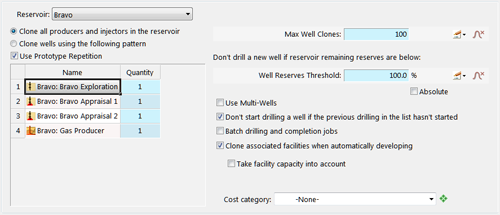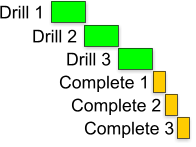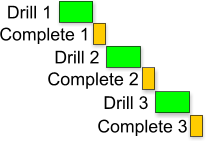Automatic Development
Automatic Development jobs allow you to instruct a reservoir to calculate the number of wells (and facilities) it needs to completely deplete its reserves using as prototypes wells and facilities already defined, and allow them to be cloned.
When you create an Automatic Development job in the Schedule and select a reservoir, the Automatic Development pane in the reservoir Details Tab (Reservoir) is activated; conversely, activating that pane automatically the corresponding job in the Schedule. The inputs related to development (pattern, number of clones, drilling policies etc.) are repeated from the job specification area and can be edited in either place.

The reservoir's defined reserves and area serve as limits for this job, which means that, when told to automatically develop a reservoir, PetroVR clones its wells as many times as possible until any of the two limits is reached. Note that the area only acts as a limit when Well Spacing has been enabled and defined in the reservoir Details Tab (Reservoir).
- Reservoir: Select the reservoir to perform automatic development.
To define which wells are subject to cloning, you can:
- Clone all producers and injectors in the reservoir: Let PetroVR use all the productio.n and injection wells defined in the reservoir as the pattern to be cloned.
- Clone wells using the following pattern: Define a subset of the reservoir's wells as the pattern to be cloned.
The calculation of how many wells are needed to deplete a reservoir is performed before the simulation starts, based on the provided inputs. This means that those clones will be scheduled to be drilled regardless of any changes brought about by simulation events and which may impact the reservoir reserves, the well production profiles, etc. All clones scheduled by an Automatic Development job will be drilled unless the reservoir is already depleted, or the prototype is abandoned by an Abandonment job or a Shut In Excess Policy.
An Automatic Development job will only clone its prototype wells if their reserves are known in advance, because the number of clones is calculated to produce all the reserves, which is impossible when well reserves are initially unknown. Examples of this situation are Gas reservoirs that have a dynamic performance type such as Deliverability (Performance Type), or cases when Perfect Communication is enabled, or (oil) reservoirs where all producers share the same performance curve.
When a PI Ratio has been defined in the Water Injection Options of the reservoir Injection Tab, the drilling sequence of clones may be altered. Injectors will always be introduced to meet the PI Ratio; i.e., producers will keep being cloned until depleting the reservoir, and a new injector will be cloned every time the PI Ratio necessitates it.
If you include dry holes, exploration wells or appraisal wells in the pattern, the prototypes will be drilled but not cloned. To drill clones of these wells use a Well & Facility Cloning job.
- Max Well Clones: Use this option to make sure that the number of clones does not surpass a given threshold. In this way you can model a further restriction other than Reservoir Reserves or Reservoir Area.
- Use prototype repetition: Enable this option to let a pattern include more than one copy of a well. A
- Quantity column will appear in the table to specify the number of copies the pattern will include. This input is a full-featured variable; right-click on the cell to access the available options, such as entering a probability distribution or defining it as a function.
Patterns with prototype repetition enabled processes its wells as presented in the table. A pattern with 3 copies of well A and 2 of well B will drill sequences of AAABB in that order.
The drilling of the prototype counts as the first prototype repetition.
- Use Multi-Well: Conflate series of well clones in order to optimize the use of computational resources. See Multi-Wells Don't start drilling a well if the previous drilling in the list hasn't started: The order in the list will be the one followed by the various rigs to which the drilling/completion of clones are assigned: each well in the list takes precedence over those that come after. It may happen, however, that the order of precedence is broken if the conditions for a drilling/completion to be performed are met before those for a well that precedes it. Check this box if you wish PetroVR to honor the exact order in the list. Unchecking it may allow you to take full advantage of rig availability, like in the following examples (where injector Devonian I3 uses a different rig from that used by the two producers which are first in the list):

The option is checked: Devonian I3 waits until the drilling of Devonian P2 has started.
Note that this option operates only inside the same iteration of the pattern. It does not imply anything about other pattern iterations that may be using use the rigs.
- Batch drilling and completion job: Use this option to force all drilling jobs in each pattern replication to be performed before starting with the first completion in the same replication.

"Batch drilling..." checked: all drilling jobs are performed first.

"Batch drilling..." is unchecked: each completion is performed right after its drilling.
- Clone associated facilities when automatically developing: Associated facilities are those that directly receive fluids from wells included in this Plan. The Plan will clone facilities when the Max Connected Wells entered in the General Tab (Facility) is reached. Additionally, you can choose to:
- Take facility capacity into account: Enable this option to clone the facility when its defined capacity is not enough to process a given percentage of the added initial rates of the wells connected to it. This percentage is entered as a Well Initial Rate Factor. E.g., enabling this option with an 50% W.I.R. Factor means that the facility will be cloned whenever the initial rates of the connected wells double the facility's capacity. This allows you to adjust the capacity reserved for each well to what its production rate will be at a later stage of its lifecycle rather than at the moment it goes online.
If the pattern contains only one prototype well, enabling the Batch drilling... option will cause all replications to be drilled before the first completion job starts.
Facility clones created by an Automatic Development job are not included in other jobs that refer to their original facility (which may be Abandonment, Facility Production Rerouting, Facility Expansion and Facility Maintenance).
